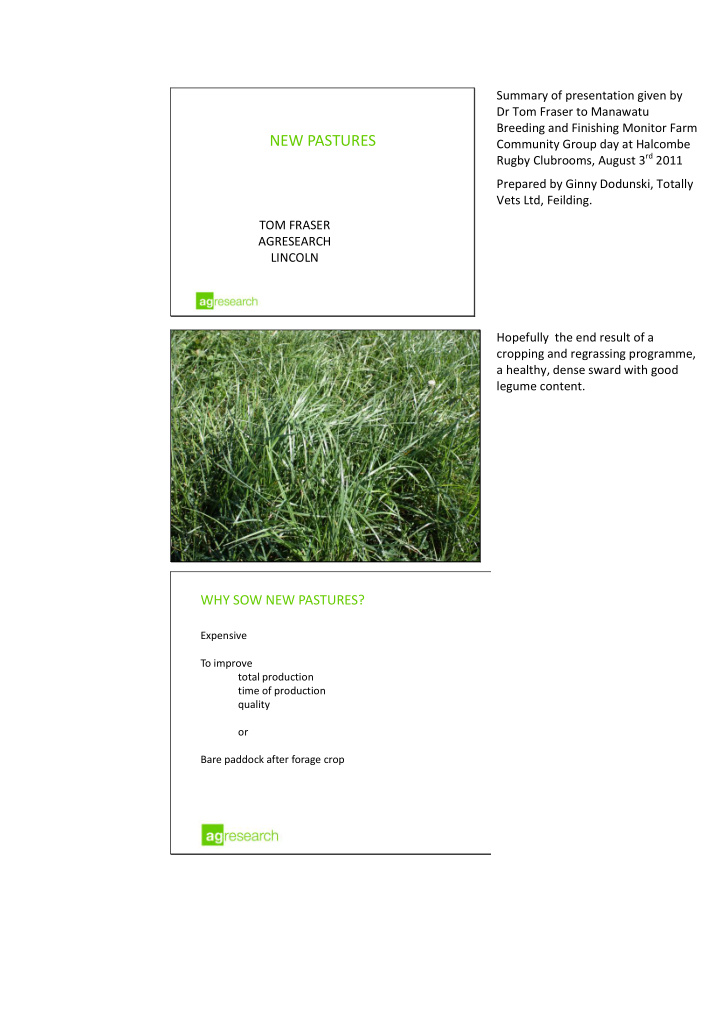



Summary of presentation given by Dr Tom Fraser to Manawatu Breeding and Finishing Monitor Farm NEW PASTURES Community Group day at Halcombe Rugby Clubrooms, August 3 rd 2011 Prepared by Ginny Dodunski, Totally Vets Ltd, Feilding. TOM FRASER AGRESEARCH LINCOLN Hopefully the end result of a cropping and regrassing programme, a healthy, dense sward with good legume content. WHY SOW NEW PASTURES? Expensive To improve total production time of production quality or Bare paddock after forage crop
TERMINOLOGY Pasture renewal - any method of establishing new pasture Full cultivation – spray existing pasture, ploughing, discing, roller-tilling etc before sowing Spray & drill - kill existing pasture using herbicide then direct drill grass seed Undersowing – direct drill grass seed into existing pasture Oversowing – spreading seed on soil surface Work out costs for your own MAKING THE BEST OUT OF NEW PASTURES operation: Wishnowsky ’ s = $770/Ha Must get good establishment poor establishment is the main reason for poor performance When established treat differently to old pastures cost $1200/ha plus don’t overgraze don’t graze during stress periods requires high fertiliser inputs Expect greater production Book contractor early, monitor their BASICS FOR ESTABLISHMENT work (get the seedbed you need not what they want to do under time Planning constraint!) should start a year before sowing new pasture contractor Why does pasture need renewing? soil fertility drainage weeds and pests poor animal performance Identify the reason and fix the problems
The reverse applies: If you don ’ t BASICS FOR ESTABLISHMENT have all of these you won ’ t get good establishment. Seedbed preparation fine firm moist weed free Similar requirements for spray drill conditions There is minimal difference in SOWING DEPTH emergence at 2 weeks between broadcast and 20mm sowing depths, Effect of sowing depth on ryegrass emergence but 50mm is too deep. 100 Percentage of sown seeds 80 60 40 20 0 0 5 10 15 20 25 30 35 Time from sowing (Days) Broadcast 5mm 10mm 20mm 50mm Clover seed is best sown at 5 – SOWING DEPTH 10mm, and at 50mm none will germinate. Effect of sowing depth on white clover emergence 100 Percentage of sown seeds 80 60 40 20 0 0 5 10 15 20 25 30 35 Time from sowing (Days) Broadcast 5mm 10mm 20mm 50mm
CHOICE OF SPECIES/CULTIVARS What is the objective for the pasture? persistence quality production Ryegrass may not be best option White clover may not be best option CHOICE OF RYEGRASS SEED • Select endophyte • Flowering date • Diploid or Tetraploid? • Then cultivar • Certified seed AR1 persistence: Partly resistant to black beetle which occurs north of Taupo ASW BB MB RootA Slug GG Por Overgrazing of AR1: Nil Easy to let happen as stock prefer it AR1 Do no sow in marginal areas where persistence is problem for all ryegrasses WT AR37 let us understand root AR37 aphid (observed bigger roots) Root aphid chronic pest especially in late autumn early winter--- waxy white in root zone mistaken for fungus
Don ’ t feed hay on nil or low NOVEL ENDOPHYTE endophyte paddocks unless it ’ s MANAGEMENT from same source • More palatable than wild endophyte • Animals preferentially graze Novel and Nil Potential reseeding of wild • Lacks toxins in plant base to deter grazing animals • Novel endophyte requires: Higher residuals Protection from grazing when stressed SOWING RATE FOR RYEGRASS Industry guidelines 15-30 kg/ha some research suggests 6-12 kg/ha 18 kg/ha = 9 million ryegrass seeds/ha = 810 plants/m 2 Stable ryegrass pasture: 250-350 plants/m 2 Ryegrass sowing rates are too high for good legume establishment Tetraploids need a heavier rate than diploids 1% doesn ’ t sound much, BUT SEED CERTIFICATIOCERN when calculated it equals 23 weeds per metre Squared!!!!! Quality seed represents the basic building block AND it is guaranteed (Murphy ’ s law) that the majority of these In a sowing mix of 20kg/ha ryegrass and 3 kg/ha weeds WILL germinate and white clover… establish! 1% weed seed = 230 000 weed seeds/ha or 23/m2 P & G certificate supplies information on the purity and germination of the seed line
The P and G cert has a heap of SEED CERTIFICATION CERTIFICATE info on it. It includes traceability right down to the actual paddock in the case of a certified line. This particular line is a first generation certified line of seed. Very good purity. Inert matter are things like dirt, chaff, straw etc. 0.2% other seed: Fathen and Wireweed Also get a certificate for endophyte type and level which is very important. IT ’ S ALSO FREE! Ask seed agent for a copy, they can get one very easily either electronically or faxed very quickly. Don ’ t buy seed without one – important to be fully informed when making expensive decisions such as these. Take home line: Nitrogen is not just MANAGEMENT – YEAR 1 for dairy farmers! Sheep and beef farmers ARE allowed to use Graze first when plants survive “pluck test” Nitrogen! Graze regularly to encourage shoot growth - 10 cm to 3 cm residual Use nitrogen (20-25 kg/ha) to increase plant size before summer Silage etc in first spring reduces growth and persistence Avoid overgrazing Please fertilise it is meant to grow more
WEED CONTROL Use herbicides to control weeds Apply herbicides when weeds are small Less competition, favours grass and clover seedling growth
Recommend
More recommend